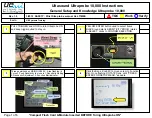
6-11
Maintenance
Cleaning Connections for Accurate Measurements
The soft core, while allowing precise centering, is also the chief liability of the
connector. The soft material is easily damaged. Care must be taken to mini-
mize excessive scratching and wear. While minor wear is not a problem if the
glass face is not affected, scratches or grit can cause the glass fiber to move
out of alignment. Also, if unkeyed connectors are used, the nickel silver can be
pushed onto the glass surface. Scratches, fiber movement, or glass contamina-
tion will cause loss of signal and increased reflections, resulting in poor return
loss.
Inspecting Connectors
Because fiber-optic connectors are susceptible to damage that is not immedi-
ately obvious to the naked eye, poor measurements result without the user
being aware. Microscopic examination and return loss measurements are the
best way to ensure good measurements. Good cleaning practices can help
ensure that optimum connector performance is maintained. With glass-to-
glass interfaces, any degradation of a ferrule or the end of the fiber, any stray
particles, or finger oil can have a significant effect on connector performance.
Where many repeat connections are required, use of a connector saver or
patch cable is recommended.
shows the end of a clean fiber-optic cable. The dark circle in the
center of the micrograph is the fiber’s 125
µ
m core and cladding which carries
the light. The surrounding area is the soft nickel-silver ferrule.
shows a dirty fiber end from neglect or perhaps improper cleaning. Material is
smeared and ground into the end of the fiber causing light scattering and poor
reflection. Not only is the precision polish lost, but this action can grind off the
glass face and destroy the connector.
shows physical damage to the glass fiber end caused by either
repeated connections made without removing loose particles or using
improper cleaning tools. When severe, the damage of one connector end can
be transferred to another good connector endface that comes in contact with
the damaged one. Periodic checks of fiber ends, and replacing connecting
cables after many connections is a wise practice.
The cure for these problems is disciplined connector care as described in the
following list and in
Summary of Contents for 86140B Series
Page 2: ...Agilent 86140B Series Optical Spectrum Analyzer User s Guide ...
Page 11: ...1 4 Getting Started Product Overview Agilent 86140B Front and Rear Panels ...
Page 12: ...1 5 Getting Started Product Overview ...
Page 14: ...1 7 Getting Started Product Overview Figure 1 2 Display Annotations ...
Page 28: ...1 21 Getting Started The Softkey Panels ...
Page 33: ...1 26 Getting Started The Softkey Panels The Systems Menus continued ...
Page 41: ...1 34 Getting Started Product Options and Accessories ...
Page 79: ...2 38 Using the Instrument Analyzer Operating Modes ...
Page 80: ...3 Function Reference ...
Page 239: ...6 2 Maintenance Changing the Printer Paper Changing the Printer Paper ...
















































